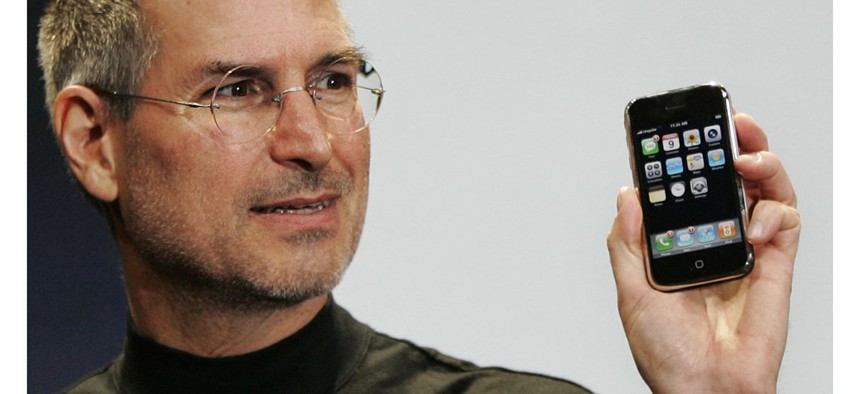Steve Jobs Taught Me That Before Employees Can Be Creative, They Have to Feel Psychologically Safe

Then-Apple CEO Steve Jobs demonstrates the new iPhone during his keynote address at MacWorld Conference in 2007. Paul Sakuma/AP File Photo
Workplaces should be engines where new ideas are rapidly exchanged and tested.
I was once in a meeting with Steve Jobs where he admitted he has been wrong. I was involved in the design of the common dining area at the Pixar atrium at the time, and it was an awesome trust-building moment for the team. We were discussing the look of the exposed steel beams and how they should relate to the overall design.
Suddenly, Jobs stood up and started pacing around the front of the room, questioning the founding aesthetic direction he had set not just for the steel, but for the whole building. He asked us, “Is this aesthetic we’ve chosen the right story we want to tell?”
Jobs took time to re-examine his rational and, in doing so, set an example of how it’s OK to share doubt, even if it makes us look imperfect. Sharing that moment of vulnerability modeled what successful teamwork really felt like; strength is being able to reveal one’s vulnerability so we can all work better together.
Workplaces should be engines where new ideas are rapidly exchanged and tested, but great conversations and teamwork won’t thrive when you’re not feeling supported and psychologically safe. The need to feel secure in order to take risks profoundly affects our ability to do our best work. Through exploring this notion, Google’s Aristotle Project sought to understand why some teams performed better than others. They found that the most successful teams weren’t the ones with the highest collective IQs: By a large margin, they were the ones with a sense of psychological safety, which they defined as “an individual’s perception that a team is safe for risk taking in the face of being seen as ignorant or incompetent.”
Consider the science behind the neurochemical cascade of distrust and insecurity. “When your brain is picking up signals of distrust, more likely than not your brain produces cortisol, which closes down our prefrontal cortex, where new ideas, creative thinking, empathy, and good judgement reside,” says anthropologist and management coach Judith Glaser in her book Conversational Intelligence. “Signals get sent to the amygdala to take over to protect, and cause higher levels of norepinephrine causing more negative thoughts and desire to fight.”
When you don’t feel psychology safe within your workplace, a team’s success rate drastically diminishes. Individuals are afraid to ask questions or challenge dominant group-think. Concealing our thoughts so that we’re less vulnerable to criticism is a form of impression management, and aside from taking processing power away from the job at hand, it can have enormous consequences in team scenarios. As evidenced by Amy Edmondson’s TEDx talk on psychological safety, we all feel vulnerable sometimes, especially amidst uncertainty and interdependence.
But vulnerability also has an invaluable superpower: It builds trust between people. Revealing our fallibility, just as Jobs did in that meeting, demonstrates that we accept ourselves as imperfect and tacitly shows that we won’t judge others for being imperfect, either. Edmonson says that acknowledging your fallibility fosters psychological safety in interpersonal and workplace settings. And when people feel safe enough to risk sharing their ideas, groups thrive.
Innovation demands that people work together in uncertainty, encountering new problems with unpredictable outcomes. And with the state of uncertainty currently befalling many industries—of automation, of trade barriers, of market stability—buildig a culture where we keep each other psychologically safe as we take risks together is more important than ever.


